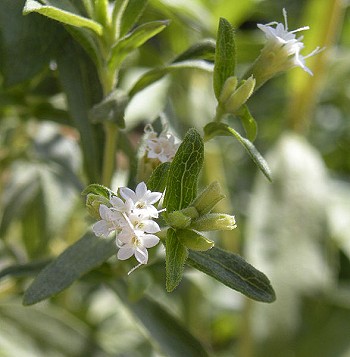
|
|
Stevia
rebaudiana (flowers)
|
Stevia - Stevia
rebaudiana
Stevia is a genus of about 240 species of herbs and shrubs in the sunflower family (Asteraceae), native to subtropical and tropical regions from western North America to South America. The species Stevia rebaudiana, commonly known as sweetleaf, sweet leaf, sugarleaf, or simply stevia, is widely grown for its sweet leaves. As a sweetener and sugar substitute, stevia's taste has a slower onset and longer duration than that of sugar, although some of its extracts may have a bitter or licorice-like aftertaste at high concentrations.
With its extracts having up to 300 times the sweetness of sugar, stevia has garnered attention with the rise in demand for low-carbohydrate, low-sugar food alternatives. Medical research has also shown possible benefits of stevia in treating obesity and high blood pressure. Because stevia has a negligible effect on blood glucose, it is attractive as a natural sweetener to people on carbohydrate-controlled diets. Health concerns and political controversies have limited stevia's availability in many countries; for example, the United States banned it in the early 1990s unless labeled as a supplement, but in 2008 approved rebaudioside-A extract as a food additive. Some countries continue to limit or ban its use until existing applications are evaluated. Stevia is widely used as a sweetener in Japan, South America, Switzerland, Australia, New Zealand and parts of
Asia.
The genus Stevia consists of 240 species of plants native to South America, Central America, and Mexico, with several species found as far north as Arizona, New Mexico, and
Texas. They were first researched by Spanish botanist and physician Pedro Jaime Esteve, and the word stevia is a Latinized derivation of his
surname. Human use of the sweet species S. rebaudiana originated in South America. The leaves of the stevia plant have 30–45 times the sweetness of sucrose (ordinary table
sugar). The leaves can be eaten fresh, or put in teas and foods.
In 1899, the Swiss botanist Moisés Santiago Bertoni, during his research in eastern Paraguay first described the plant and the sweet taste in
detail. But only limited research was conducted on the topic until, in 1931, two French chemists isolated the glycosides that give stevia its sweet
taste. These compounds were named stevioside and rebaudioside, and are 250–300 times sweeter than sucrose, heat stable, pH stable, and
non-fermentable.
The exact structure of the aglycone and the glycoside were published in 1955.
In the early 1970s, Japan began cultivating stevia as an alternative to artificial sweeteners such as cyclamate and saccharin, which were suspected carcinogens. The plant's leaves, the aqueous extract of the leaves, and purified steviosides are used as sweeteners. Since the Japanese firm Morita Kagaku Kogyo Co., Ltd. produced the first commercial stevia sweetener in Japan in
1971, the Japanese have been using stevia in food products, soft drinks (including Coca
Cola), and for table use. Japan currently consumes more stevia than any other country, with stevia accounting for 40% of the sweetener
market.
Today, stevia is cultivated and used in food elsewhere in east Asia, including in China (since 1984), Korea, Taiwan, Thailand, and Malaysia. It can also be found in Saint Kitts and Nevis, in parts of South America (Brazil, Colombia, Peru, Paraguay, and Uruguay) and in Israel. China is the world's largest exporter of
stevioside.
Stevia species are found in the wild in semi-arid habitats ranging from grassland to mountain terrain. Stevia does produce seeds, but only a small percentage of them germinate. Planting cloned stevia is a more effective method of reproduction.
For centuries, the Guaraní tribes of Paraguay, Bolivia and Brazil used stevia, which they called ka'a he'ê ("sweet herb"), as a sweetener in yerba mate and medicinal teas for treating heartburn and other
ailments.
More recent medical research has shown promise in treating obesity and
hypertension. Stevia has a negligible effect on blood glucose, even enhancing glucose
tolerance; therefore, it is attractive as a natural sweetener to diabetics and others on
carbohydrate-controlled diets.
Possible treatment of osteoporosis has been suggested by the patent application claim that eggshell breakage can be reduced by 75% by adding a small percentage of stevia leaf powder to chicken
feed. It has also been suggested that pigs fed stevia extract had twice as much calcium content in their meat, but these claims have been
unverified.
Source:
http://en.wikipedia.org/wiki/Stevia
http://www.stevia.net/history.htm
